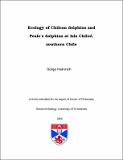Files in this item
Ecology of Chilean dolphins and Peale's dolphins at Isla Chiloe, southern Chile
Item metadata
| dc.contributor.advisor | Hammond, Philip S. | |
| dc.contributor.author | Heinrich, Sonja | |
| dc.coverage.spatial | x, 239 p., [8] leaves | en |
| dc.date.accessioned | 2007-08-09T11:56:19Z | |
| dc.date.available | 2007-08-09T11:56:19Z | |
| dc.date.issued | 2006 | |
| dc.identifier | uk.bl.ethos.552034 | |
| dc.identifier.uri | https://hdl.handle.net/10023/365 | |
| dc.description.abstract | Information on the ecology of sympatric species provides important insights into how different animals interact with their environment, with each other, and how they differ in their susceptibility to threats to their survival. In this study habitat use and population ecology of Chilean dolphins (Cephalorhynchus eutropia) and sympatric Peale's dolphins (Lagenorhynchus australis) were investigated in the Chiloe Archipelago in southern Chile from 2001 to 2004. Distribution data collected during systematic boat-based sighting surveys revealed a distinct pattern of small-scale habitat partitioning, probably reflecting differences in foraging strategies and habitat preference. Chilean dolphins were sighted consistently in the same selected bays and channels in southern Chiloe. Peale's dolphins were distributed over wider areas, and were more frequently encountered in central Chiloe. Spatial overlap between both dolphin species and mariculture farms (for mussels and salmon) was extensive. Predictive habitat modelling using logistic regression in a model selection framework proved a useful tool to determine critical habitat from absence-presence data and enviromental parameters. Chilean dolphins preferred shallow waters (< 20 m) close to shore (< 500 m) with estuarine influence. Peale's dolphins also occurred predominantly in shallow nearshore waters, but preferred more exposed shores with sandy shoals and were found further from rivers and mussel farms than Chilean dolphins. Analysis of ranging and movement patterns revealed small-scale site fidelity and small ranging patterns of individually identifiable Chilean dolphins. Individuals differed in their site preference and range overlap suggesting spatial partitioning along environmental and social parameters within the population. Individual Peale's dolphins were resighted less regularly, showed only limited or low site fidelity and seemed to range beyond the boundaries of the chosen study areas. Mark-recapture methods applied to photo-identification data produced estimates of local population sizes of 59 Chilean dolphins (95% CI= 54 - 64) and 78 Peale's dolphins (95% CI= 65 - 95) in southern Chiloe, and 123 Peale's dolphins (95% CI= 97 - 156) in central Chiloe. An integrated precautionary approach to management is proposed based on scientific monitoring, environmental education in local schools, and public outreach to promote appropriate conservation strategies and ensure the dolphins' continued occupancy of important coastal habitat. | en |
| dc.format.extent | 7498880 bytes | |
| dc.format.mimetype | application/pdf | |
| dc.language.iso | en | en |
| dc.publisher | University of St Andrews | |
| dc.rights | Creative Commons Attribution-NonCommercial-NoDerivs 3.0 Unported | |
| dc.rights.uri | http://creativecommons.org/licenses/by-nc-nd/3.0/ | |
| dc.subject.lcc | QL737.C432H45 | |
| dc.subject.lcsh | Dolphins--Chile--Ecology | en |
| dc.title | Ecology of Chilean dolphins and Peale's dolphins at Isla Chiloe, southern Chile | en |
| dc.type | Thesis | en |
| dc.type.qualificationlevel | Doctoral | en |
| dc.type.qualificationname | PhD Doctor of Philosophy | en |
| dc.publisher.institution | The University of St Andrews | en |
This item appears in the following Collection(s)
Except where otherwise noted within the work, this item's licence for re-use is described as Creative Commons Attribution-NonCommercial-NoDerivs 3.0 Unported
Items in the St Andrews Research Repository are protected by copyright, with all rights reserved, unless otherwise indicated.


